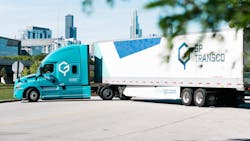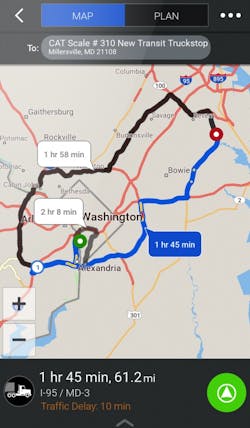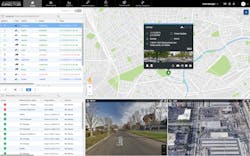Since the start of the COVID-19 outbreak in the U.S., traffic congestion has decreased significantly, essentially eliminating the difference between weekday and weekend traffic in most major cities. But with less traffic comes the possibility of speed acceleration from both commercial truckers and the general public. Now more than ever, keeping commercial drivers engaged, healthy and safe is the industry’s top priority.
To help navigate some of the new obstacles brought on by COVID-19, fleet managers can leverage the data collected from electronic logging devices (ELDs), transportation management systems (TMS), and telematics solutions to operate more efficiently and safely while keeping the lines of communication open with their drivers.
Fleet telematics provider Geotab has been continuously monitoring transportation and trade activity via its weekly blog posts from the very beginning of the outbreak. Mike Branch, vice president of data and analytics at Geotab, told FleetOwner that heavy-duty trucks have been the least impacted in terms of their utilization and activity.
As traffic congestion has decreased throughout the pandemic, the morning and evening rush hour virtually disappeared, he said. However, commercial transportation speeds in major cities have increased.
“As speed has increased in cities, we have also seen an increase in harsh braking, hard acceleration and hard cornering as measured by daily events per active vehicle— predominantly by trucks,” Branch explained.
For Chris Orban, Trimble’s vice president of data science, one of the most unanticipated impacts of COVID-19 has been the speed in which everything changed. And as traffic patterns have changed, driving behavior has shifted as well.
“Are members of the public being less aware of their surroundings because there are fewer cars on the road? Are they driving faster? One of the things I am hearing very anecdotally is the driving behaviors of the public are becoming more and more stressful for some commercial drivers,” Orban said.
How have fleets been able to keep their drivers safe, well rested, healthy and operating at full efficiency right now? It has been challenging, but doable.
Staff safety and engagement
As the safety and well-being of drivers is of top priority, fleet owners and managers can use data to take an anonymous pulse on their drivers’ health and spot potential risk areas to help ensure safe vehicle operation.
The companies delivering critical goods and services are likely to be driving long hours, and drivers are potentially being overworked, explained Kevin Aries, head of global product success at Verizon Connect.
“They are carrying a heavy burden, and that can result in potential safety issues. Continue to monitor fleets and make sure they are driving as safely as possible,” he said.
Geotab’s Branch added that in-demand fleets can use health surveys, safety reports, and customized safety rules to help ensure the health and safety of their drivers. Plus, managers can enable drivers to practice social distancing by automating customer notifications upon delivery or completion of service.
Trimble has been focused on figuring out how to get drivers to safe places to access food and rest, Orban explained, pointing to the company’s Safe Havens app.
“One of the key elements of driver safety becomes fatigue,” he noted. “As hours of service restrictions have been relaxed, fatigue becomes potentially more of an issue. It’s not always the case, but the possibility exists for drivers to push themselves harder than they should, especially when they know the load of freight they are hauling might be essential to keeping a grocery store stocked. We need to use tools to look at hours of service patterns, to look at circadian rhythms, and try to indicate when drivers might be trying to push themselves too hard.”
In addition, Fred Fakkema, Zonar’s vice president of safety and compliance, pointed out that mental fatigue could become just as problematic or even more so than physical fatigue.
“Over-the-road drivers are thinking all day long, and now they are thinking about the risks about where they are, how they fuel and making sure not to touch fuel pumps, thinking about how they are going to sanitize, and where and how they are going to take a break,” he said. “All those different things are taking place, and there is mental exhaustion as well.”
One fleet’s focus
GP Transco, a trucking and logistics company based in the Chicago area, operates in the continental U.S. and Canada. The company’s assets include roughly 400 trucks and close to 600 trailers. It also employs more than 100 office employees.
One of the bigger challenges for the carrier has been keeping drivers as busy as they were before the pandemic, as miles and rates are down, explained Jonas Bidva, GP Transco vice president of operations. Another challenge has been transitioning office staff to work from home, which is a first for the company.
But even before COVID-19, Bidva said that GP Transco had invested heavily in technology to streamline its operations. In addition to its own OpenRoad TMS, the carrier has relied on an integration with Samsara’s telematics solutions to track GPS coordinates, drivers’ hours of service (HOS), driver location, estimated time of arrival (ETA) for customers, idle monitoring and miles per gallon, and driver behavior.
“We are able to keep our drivers moving by keeping our lines of communication open,” said Marija Jamontas, vice president of safety and human resources for GP Transco. “We have held video conferences with the drivers to address their main concerns. We have also been reassuring drivers that we have resources for them and what our plan of action is, and that has been really well received.”
The company is also giving drivers hazard pay bonuses and other weekly bonuses during the pandemic. “It’s just one of the things we have done to reassure our drivers that we are in this together, and we can get through this,” she said.
To keep drivers safe while on the road and to keep operations running as smoothly as possible, GP Transco relies heavily on the data coming off its TMS and telematics solutions. The carrier’s information technology specialists regularly review driver activity and behavior, such as percentage of speeding and harsh driving events, which are calculated by Samsara.
“I am happy to report that we have not seen an increase in harsh driving events for our fleet,” Jamontas said, adding that there has been a slight uptick in speeding, which could be skewed due to less traffic volumes.
“Samsara has allowed us to track all of these events in real time, so if something does happen, we immediately communicate with the drivers,” she added. “We always communicate with our drivers and let them know how they can avoid incidents by keeping their distance, making sure they are staying below the speed limit, and making sure they are doing things safely out there.”
And even though HOS regulations have been relaxed for drivers providing direct assistance during the pandemic, GP Transco has made it a priority to check in on drivers every 30 minutes to an hour to make sure they are not tired or falling asleep.
“If they are tired, we tell them to stop completely and take their full break,” Jamontas said. “That’s the process we have in place to address the new regulatory exemptions. We plan to first and foremost make sure our drivers don’t have to go over their hours, if that’s a possibility, but we do normal check-ins to make sure our drivers are not fatigued.”
Rushil Goel, vice president and general manager of product at Samsara, explained that HOS exemptions and fewer vehicles on the road have prompted an increase in driving speeds. He said Samsara customers have been relying on telematics to detect distracted, falling asleep or drowsy driving behaviors. He added that fleet customers have been using technology to ensure front-line drivers are staying healthy and following best practices.
“We’ve had customers using our driver app as their platform to check in with their drivers. They are using the same app for pre- and post-trip inspections to make sure their trucks have been sanitized,” Goel said.
He also said the driver app is being used to practice social distancing. Drivers are using Samsara’s app to send documents remotely to customers and get a proof of delivery and signature.
Geolocation and resource utilization
Fleet management solutions provider Teletrac Navman tracks data from a variety of fleets — from long-haul trucking to school buses to oil and gas. According to Sid Nair, Teletrac Navman’s senior director of product development, the COVID-19 health crisis is both the “best of times and worst of times” when it comes to customer productivity. Right now, some fleets are using this crisis as an opportunity to realize where they are underutilized, so they can reallocate assets and resources as needed, he said.
“If they have trucks that are idle, they are getting alerted. They are using that with the knowledge that is coming from the load boards and saying, ‘OK, I have two trucks that are running empty and we can combine that data and move those trucks to where the jobs are,’” Nair explained. “They are trying to geolocate, so larger fleets with more than one base are trying to coordinate and see where they should be deploying their resources.”
Nair emphasized it is of utmost importance that fleets clearly utilize data to make intelligent decisions — like making sure drivers are close to home, safe and able to return home when they can. Of equal importance is for fleets to remain connected with end customers, he explained.
Samsara’s Goel pointed out that fleets are using real-time visibility to communicate with drivers if certain areas are closed. Samsara also provides live ETAs that fleets can share with end customers so they know exactly when deliveries will arrive.
Preventive maintenance
As fleets are looking at their data relative to safety, productivity, cost, and compliance, Fakkema noted the importance of thoroughly monitoring fuel prices and vehicle maintenance as well.
“I think vehicle maintenance will be an interesting issue once the economy starts to pick back up because we are really seeing a decrease in that as well,” he said. “Fleets are working in shifts and trying to do social distancing with technicians. Once the economy gets started, you are going to have a wave of maintenance issues that will come to fruition.”
Through its Fleet Health feature, Zonar can monitor vehicle fault codes and deliver that data to truck technicians and back to the driver if there is an issue with the vehicle. Fakkema stressed the importance of continuing proper pre- and post-trip inspections to look for potential problems as well.
Additional challenges right now include potential delays in new-equipment delivery, which is especially concerning considering the industry is sitting on at least four months’ worth of inventory backlogs.
“Maintenance and repair (M&R) is traditionally a large area of expense for fleets, and given the current circumstances, additional M&R expenses from trucks that are not properly maintained can further erode a fleet’s financial picture in a time when the economic situation has placed great strain on fleets, their drivers, and certainly the financial health of the organization,” Fleet Advantage’s Flynn explained.
Prepping for the COVID-19 aftermath
Right now, one of the biggest challenges for fleets is not knowing what is next or how to plan for the future.
“A lot of our customers aren’t really sure what the demand is for their services one month, three months, or six months from now,” Aries said. “That is a challenge and a source of anxiety for many.
“In general, this is just a great time for businesses to be looking more at data as a whole,” he added. “Many companies say they don’t have time to look at data and optimize their business. Now, there has never been a better time to really think about how to take business to the next level.”
Flynn noted the importance of remaining focused on the larger picture, with long-term business strategies in mind.
“Proactive fleets that may have been considering modernizing their fleet and updating their equipment will realize that this is an opportune time to be analyzing the age of their assets and plan for the recovery,” he explained. “A recovery will take place, and fleets should recognize that pent-up demand will eventually be realized, and fleets will need to be prepared to accommodate with updated equipment that offer advanced safety features.”
But one of the hardest things right now from a data standpoint, according to Orban, is not being able to look to the past to predict what will come.
“I’ve seen a lot of comparisons to the 2008 economic crash,” he said. “Well, this is different because there is a public health component to this. It’s not just around the financial markets— everything is going to be impacted here. People’s decision-making is going to change after this crisis is over.”
Moving forward, Orban stressed the need for a marketplace that allows all players to participate fairly and to move goods and services to the right places, at the right price, and in a fair and balanced way.
“We have to get there. If you’re a carrier and capacity diminishes and you crank up all your rates for your shippers, they are going to remember that and might punish carriers in the future,” Orban said. “Similarly, shippers right now are trying to lowball carriers, and that will result in bad faith in the future. We can’t behave that way. We are all in this together, and I understand that people are trying to make money, but we’ve got to get through this together.”
About the Author

Cristina Commendatore
Cristina Commendatore is a past FleetOwner editor-in-chief. She wrote for the publication from 2015 to 2023.


